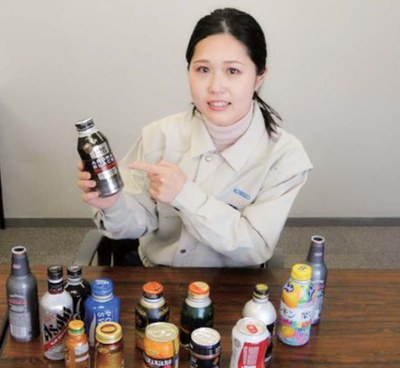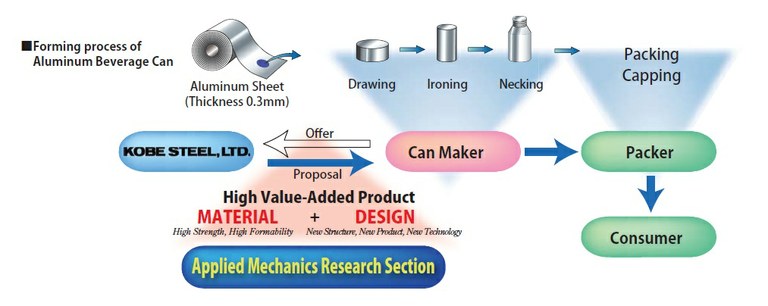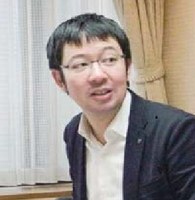4th Graduate Interview 【In Her Second Year on the Front Lines of Manufacturinkaxt】
Graduate:
|  |
|---|
Designing not only strength but sensory appeal as well
Shibuta : What kind of work are you presently engaged in?
Kashima : I'm in the Analytical Technology Research Office in the Aluminum & Copper Business Department. I'm working on the design of structures that are more effective in terms of both strength and cost using aluminum materials, as well as developing formation methods, all from a material manufacturer's perspective. Recently I've been working on the strength design for aluminum cans (the so-called “bottle cans,” which are cans shaped like a bottle).
Shibuta : When you design an aluminum can,what is the most important thing that is needed?
Kashima : The problem of how to make it light. For example, even just making the can wall thinner in 1.0μm increments makes it quite a bit lighter. But on the other hand it has to maintain enough strength to withstand the weight of around 200 kg from above. We try to design structures that can maintain both of these things and are also advantageous in terms of cost.
Shibuta : Apart from light weight, what else are you focusing on?
Kashima : Well, for example, there is a diamond-cut can whose body is formed using the famous “Miura map fold” method used in the development of satellite panels. This structure is resistant to pressure in the axial direction,and when the can is opened, the pressure is released and the Miura map fold surface texture is emphasized. The loud POP! that you hear when you open the can defines the image of the product. I think it's really interesting that not only the strength but also the sensory appeal is produced by the structural design.
Shibuta : Do you use analysis techniques,meaning simulations, in the design process?
Kashima : We use both experimentation and analysis. For analysis. we conduct structural analysis using the finite element method and perform optimization calculations for the topology and so on. And we perform strength tests for the structures that we've actually designed to test whether or not the axial strength meets the required standards.
Shibuta : What are the advantages of introducing simulations?
Kashima : Currently finite element analysis for aluminum cans can be conducted in about five to six hours, and it's possible to predict the strength of an object within a realistic period of time.
Shibuta : In university research, we sometimes use the fact that we've conducted large-scale calculations on the order of several weeks to several months as a selling point. But when you're developing a product at a company and you have a limited amount of time before the deadline, it's more important to produce the de sired result within a realistic period of time. Conversely, is there also the problem that you need the help of computers even if it takes time?
Kashima : To give just one example, there was a problem in which variations in strength were produced in the rolling process due to anisotropy in crystal orientation,and one section of the can would crumple when the can was subjected to internal pressure.Highly precise control of the material structure is needed to resolve this problem,so we have to put a lot of work into experiments based on metallurgical tests. Currently I'm in charge of the strength design aspects. But as a material manufacturer, I think that it would be advantageous if it were possible to perform computer analysis seamlessly for everything from optimal control of the material structure through structural design, to be able to actively control the material structure so it meets the desired objectives.
 The clear realization that material science is the foundation of manufacturing led to a career path at a manufacturer
The clear realization that material science is the foundation of manufacturing led to a career path at a manufacturer
Shibuta : You mentioned control of the material structure. As I understand it, you were engaged in research on a related topic in your student days.
Kashima : Yes. I conducted research into simulations of solidification structure formation within convection flows in the laboratory of Professor Tomohiro Takagi at the Kyoto Institute of Technology.
Shibuta : Can you go into a bit more detail about the content of the research?
Kashima : I used the phase-field method to analyze the growth of solidification structures taking into account the convection flow that are produced during the casting process, and the dynamic effect of the convection flow on the fragmentation of dendrites (the dendritic crystals that branch out in multiple directions).To be more specific, I used the Navier-Stokes equation that is a basic equation for fluids, and the phase-field equation to perform coupled numerical analysis.
Shibuta : The phase-field method is a method that has been widely introduced for free boundary problems, as an analysis method that expresses changes in complex interface shapes in terms of the evolution over time of the distribution of order parameters. Did you develop the code by yourself?
Kashima : I used code that had been developed in our laboratory, modifying it so it would fit my model. That's how I learned how to program. Now we use mostly packages, but the things that I learned in my student days are really proving useful in my work now.
Shibuta : Did you have any opportunities to present the results of your research when you were a student?
Kashima : Yes. I had presentations at international conferences overseas twice and at conferences in Japan many times. In the beginning,I did not like to make presentations in front of people, but in the course of presenting over and over again I got over my dislike for the most part. And it turned out to be a great opportunity. Also, it was good stimulation to have the opportunity to speak with professors who are conducting cutting-edge research.
Shibuta : What left the deepest impression on you through the research you conducted in your student days?
Kashima : When we conducted actual simulations of structure formation in cast structure solidification, I realized how wide-ranging the impact that materials science has on everything in terms of the most basic aspects of manufacturing. That was when I decided to apply for a job at materials manufacturers after I graduated.
A child who ‘loved to take things apart’
Shibuta : Why did you decide to major in mechanical engineering at college?
Kashima : I liked building things even when I was a little girl. So I guess I've always been interested in “manufacturing.”
Shibuta : What kind of things did you build?
Kashima : It wasn't so much building as wondering how things were constructed and liking to take them apart. For example, I disassembled my alarm clock. And then I couldn't put it back together again. (Laugh)
Shibuta : So you were a classic example of a mechanically minded person. (Laugh) Was the influence of your family a big factor?
Kashima : It was the influence of my father. He also liked to take various things apart. I used to enjoy watching him do that.
Shibuta : What were you interested in when you actually began majoring in mechanical engineering at college?
Kashima : When I listened to lectures at the college, I also became interested in fluid dynamics. I was fascinated that you can use the Navier-Stokes equation, a basic equation, to visualize phenomenon like currents that you can't see, using computational fluid dynamics(CFD).
Shibuta : I see. That aspect is definitely intriguing.
Kashima : In my student days, I was able to conduct research into material structure from the standpoint of both fluid dynamics and material mechanics. That was a tremendous experience for me.
Shibuta : As your sphere of activity has expanded from the university to a company setting, you've been able to truly experience how your interest grows broader as it is combined with various types of knowledge and experience, and that must give you a lot of self-confidence. What are your goals for the future?
Kashima : I want to actively participate in exhibitions and international conferences overseas, and engage in design and development from a global perspective.
Shibuta : We're looking forward to the results of your wide-ranging endeavors.
 |
|
|---|
(January 20, 2014 at Kobe Corporate Research Laboratories, Kobe Steel, Ltd.) (Photo: Tomohiro Takaki, Kyoto Institute of Technology)

